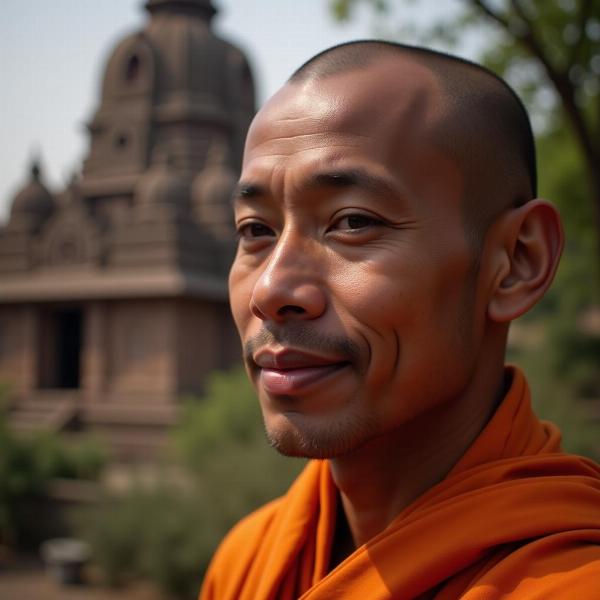Understanding the meaning and cultural connotations of “bald” in Hindi is crucial for anyone navigating Indian culture or working with the Hindi language. This article will explore the various Hindi words for “bald,” their nuanced meanings, and the cultural perceptions surrounding baldness in India. We’ll delve into the social implications, common idioms, and even touch on traditional remedies often associated with hair loss.
Different Words for “Bald” in Hindi
While the most common and straightforward translation of “bald” in Hindi is “गंजा” (ganja), several other words exist, each with its own subtle shade of meaning. Let’s examine some of the most common terms:
- गंजा (Ganja): This is the most frequently used term and generally refers to complete or near-complete baldness.
- टकलू (Taklu): This word often carries a slightly more informal and sometimes even playful connotation, and can be used to describe someone with partial baldness, particularly on the crown of the head.
- उजड़ा (Ujada): This term implies desolation or barrenness, and when used in the context of hair, it signifies a more severe or advanced stage of baldness.
- खाली (Khali): While literally meaning “empty,” this word can be used colloquially to refer to a bald head.
Cultural Perceptions of Baldness in India
Baldness is viewed in various ways within Indian society. While some consider it a sign of aging or even weakness, others associate it with wisdom, spirituality, and even power. Historically, many religious figures and ascetics have embraced baldness as a symbol of renunciation and detachment from worldly possessions.
For example, Jain monks traditionally practice complete hair removal as part of their spiritual journey. This act signifies their commitment to a life of simplicity and non-attachment.
Idioms and Expressions Related to Baldness
The Hindi language incorporates several idioms and expressions related to baldness, often used humorously or metaphorically:
- “गंजेड़ी पर चोट” (Ganjeedi par chot): This translates to “a blow to a bald head,” and is used to describe a situation where someone is unfairly targeted or victimized.
- “टकलू होना” (Taklu hona): This phrase, meaning “to become bald,” can also be used figuratively to express feelings of being cheated or deceived.
 Bald Head of an Indian Monk
Bald Head of an Indian Monk
Baldness and Traditional Remedies
In India, a rich tradition of Ayurvedic medicine offers various remedies for hair loss. These treatments often involve herbal oils, pastes, and dietary recommendations believed to promote hair growth and prevent further loss. While the effectiveness of these remedies varies, they highlight the cultural significance of hair and the desire to maintain a healthy mane.
Addressing Common Concerns About Baldness
Many individuals experiencing hair loss often seek solutions. This can range from embracing the bald look to exploring medical treatments like hair transplants. The best approach depends on individual preferences and the underlying cause of hair loss.
Quote from Dr. Anjali Sharma, a renowned Ayurvedic practitioner in Delhi: “Hair loss can be attributed to a variety of factors, from genetics and stress to nutritional deficiencies. Ayurveda offers holistic approaches that address the root cause of the problem, promoting overall well-being while supporting healthy hair growth.”
Conclusion
Understanding the meaning of “bald” in Hindi goes beyond simple translation. It involves appreciating the cultural nuances, social perceptions, and even the traditional remedies associated with hair loss in India. From “ganja” to “taklu,” each term offers a unique perspective on this aspect of Indian culture.
FAQ
- What is the most common Hindi word for “bald”? Ganja (गंजा) is the most commonly used word.
- Is baldness viewed negatively in India? Not necessarily. While some see it as a sign of aging, others associate it with wisdom and spirituality.
- Are there any traditional remedies for baldness in India? Yes, Ayurveda offers various herbal remedies and treatments for hair loss.
- What does “taklu” mean? It often refers to partial baldness, especially on the crown, and carries a more informal connotation.
- What does “ujada” signify regarding hair? It implies a more severe or advanced stage of baldness, suggesting barrenness.
- Is “khali” used to describe baldness? Yes, colloquially, “khali” (meaning empty) can refer to a bald head.
- What is the cultural significance of hair in India? Hair is often associated with beauty, health, and even spiritual strength in Indian culture.
Meaning-Hindi.in: Your Expert in Hindi Language and Culture
Meaning-Hindi.in is your one-stop solution for all your Hindi translation needs. We specialize in various translation services, including business and commercial document translation, certified and legal document translation, technical and user manual translation, website and localization services, educational and academic document translation, express translation, and specialized industry translation. Our deep understanding of Hindi grammar, literature, customs, and religion ensures accurate and culturally sensitive translations. Whether you need a document translated for business, legal, or personal purposes, Meaning-Hindi.in has the expertise to deliver high-quality results. Contact us today at [email protected] or +91 11-4502-7584 to discuss your translation requirements.